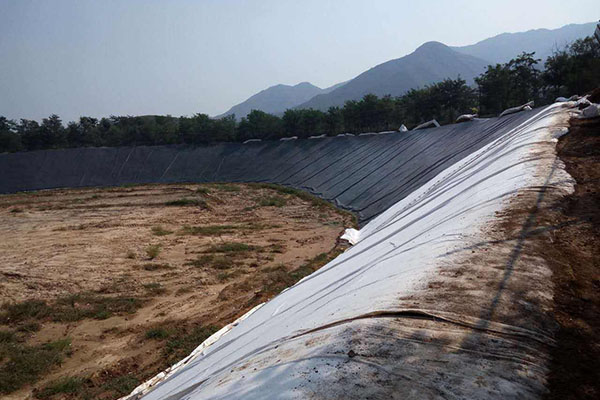The anti-seepage structure of the
composite geomembrane consists of a protective layer, an upper buffer layer, an anti-seepage layer, a lower buffer layer and a support layer in sequence. The foundation soil of the project is of medium thickness. After dredging and adjusting the slope, leveling and mechanical rolling to reach the compaction standard, it can be used as the bottom and support layer of the composite geomembrane. Different parts of the upper cushion are treated differently. In flooded areas, the upper cushion is compacted with porous soil with an average thickness of 30 m, and then a 10 cm thick reinforced concrete slab is poured into the block as a protective layer and spillway cover plate; in the water area, the upper cushion is made of average It is made of porous soil with a thickness of 60 cm, which is layered and compacted, and then a wire cage with a thickness of 40 cm is made into a protective layer. The composite geomembrane of the water storage section is firmly connected with the composite geomembrane under the bottom of each rubber dam to form a fully enclosed anti-seepage structure layer.
Before the construction of the artificial landscape lake composite geomembrane enters the site, it will be sent to the laboratory of Taiyuan University of Technology for testing, and it can be put into use after all the indicators are qualified. The composite geomembrane must be inspected on site during on-site construction.
The commonly used inspection methods are as follows:
Visual inspection. Check the composite geomembrane carefully to determine whether the joint position is burnt, whether the surface is wrinkled, whether the welding position is uniform, etc.
Aeration method. Seal both ends of the double weld, then insert a gas needle and observe the vacuum gauge for 0.5 minutes to judge the air pressure. In the construction of composite geomembrane, a top-down construction method is required. Before placing the composite geomembrane, prepare a wooden board with the same width as the composite geomembrane and place it on the excavation base. During the placement of the composite geomembrane, four construction workers were arranged on the top of the slope to support the composite geomembrane, and a construction worker stood on the left and right sides of the placement position to support the composite geomembrane. The membrane is slowly placed on the slope. When installing two adjacent composite geomembrane layers, care should be taken to control the joint width between 150-200mm.
Composite geomembrane anti-seepage structure
Before cutting the composite geomembrane, the composite geomembrane must be cut and clearly marked according to the size requirements of the laying position. During paving construction, paving construction should be carried out to minimize welding and save building materials. When placing corners and complex terrain, care should be taken to minimize the length of the joints. In actual construction, if the slope ratio is greater than 1:5, a welded joint should be placed 1.5m below the top of the slope. In the placement and construction of the composite geomembrane, the flatness must be strictly controlled to ensure full extension and avoid wrinkles. In order to avoid the adverse effects of climate and environmental factors on the construction quality of composite geomembrane pavement, a certain margin should be reserved to prevent the expansion and deformation of composite geomembrane.

